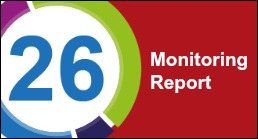
06/12/2016
Equality Commission publishes 26th Monitoring Report.
The Equality Commission has today published the Twenty Sixth Annual Fair Employment Monitoring Report which sets out the data submitted to the Commission by 138 public bodies and 3,553 private sector concerns during 2015.
Fair Employment legislation introduced workforce monitoring to certain employers, along with a requirement for them to assess, and take affirmative action to secure, fair participation in employment for members of the Protestant community and of the Roman Catholic community.
In 2015, considering only those workers for whom such a community background could be determined, [52.1%] of the monitored workforce was Protestant and [47.9%] Roman Catholic.
“This is an increase of 0.5 percentage points in the Roman Catholic share from the previous year,” Dr. Wardlow, Chief Commissioner of the Equality Commission, said. “It continues a gradual upward trend in the Roman Catholic share which has been observed since 2001. The proportions of people from a Protestant and Catholic background in the monitored workforce continue to be broadly reflective of the estimated composition of economically active people of working age in Northern Ireland. This pattern has been consistent over recent years”.
In 2015, the total monitored workforce was 529,746 - an increase of 11,249 (2.2%) since the previous year. “This is the second successive year in which the monitored workforce has increased,” Dr. Wardlow said. “It suggests that there may be a return to what had been an annual upward trend from 2001 to 2008.”
“This, however, is not the total number of people in employment in Northern Ireland,” Dr. Wardlow pointed out. “The monitored workforce comprises only the employees of all public authorities and the employees of private concerns which employ 11 or more people. That accounts for an estimated two thirds of all those in employment in Northern Ireland.”
The proportion of women in the monitored workforce decreased by 0.2 percentage points in 2015, to 52.2%. Women had increased their share of the monitored workforce almost every year between 2001 (50.4%) and 2010 (52.7%). However, after having remained relatively unchanged since 2010, this is now the second consecutive year it has decreased. In the public sector, however, the proportion of women increased by 0.3 percentage points to 65.1% of total public sector employees. That is an increase from 59.1% in 2001.
“Over the past twenty-six years employer workforce monitoring has provided employers with an evidential basis to inform their three-yearly reviews which enables them to take action to ensure fair participation within their own workforce” Dr. Wardlow concluded. “Employers, through their adoption of these and related approaches have played a key role in enabling workplaces to become more diverse and less contentious”.